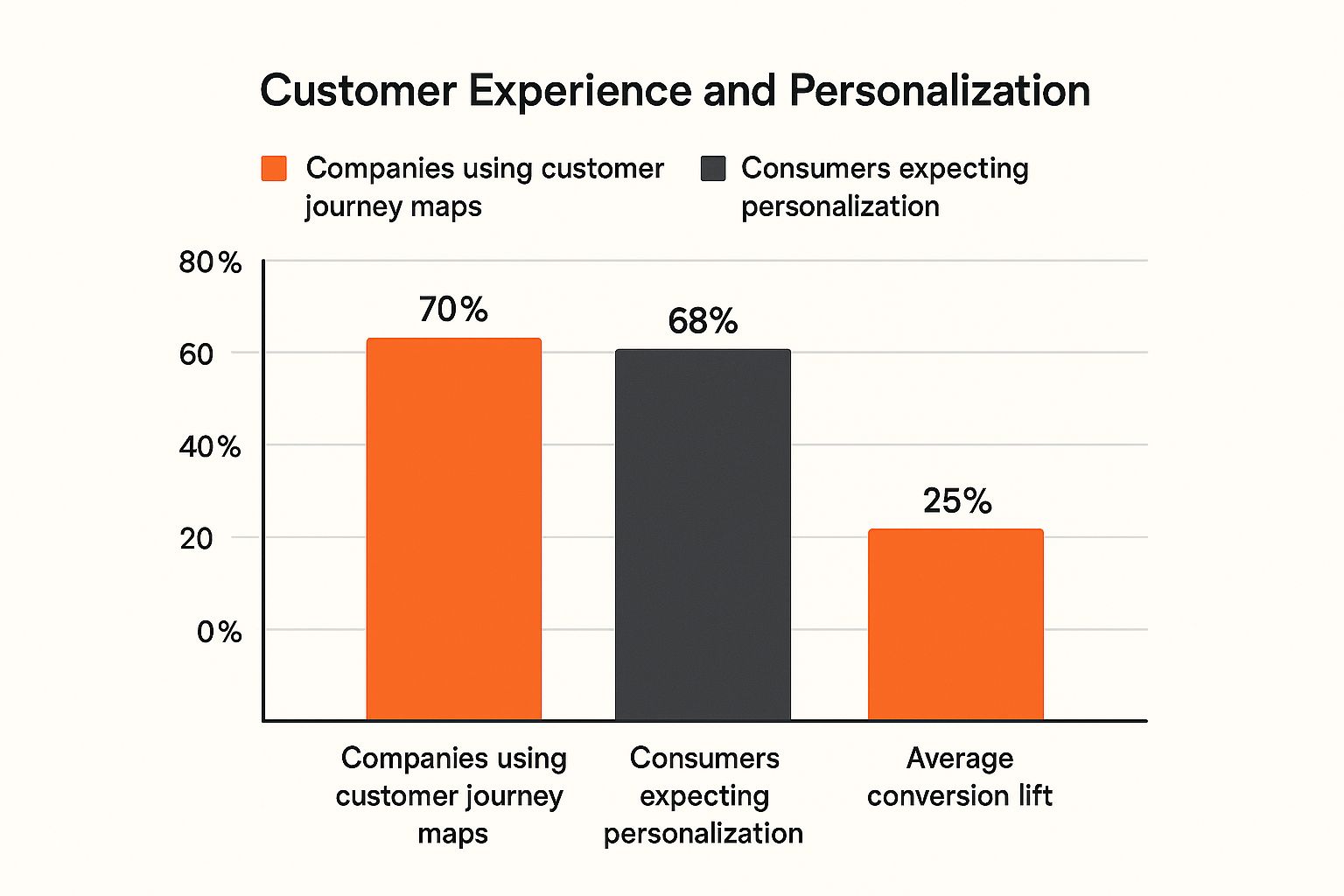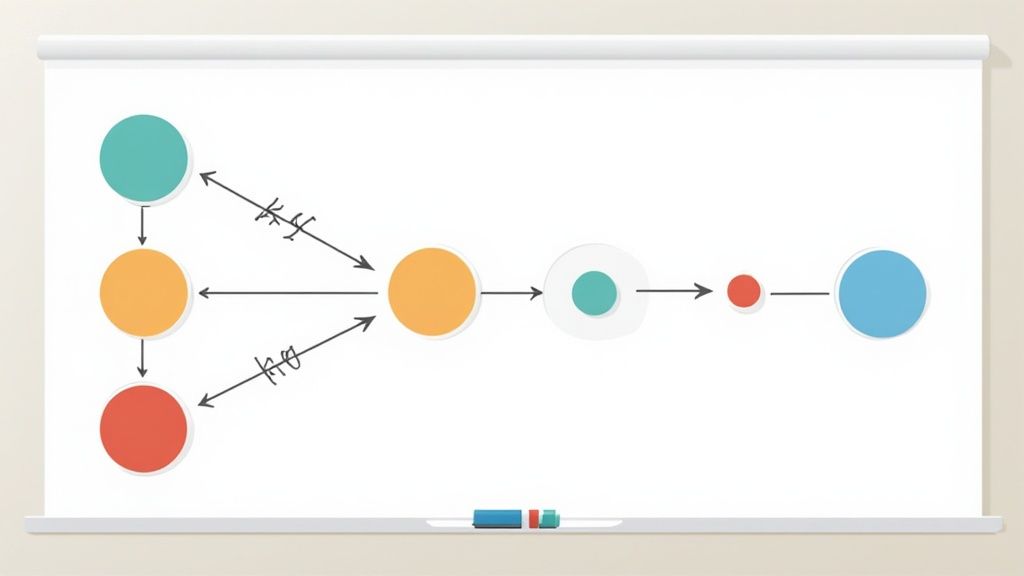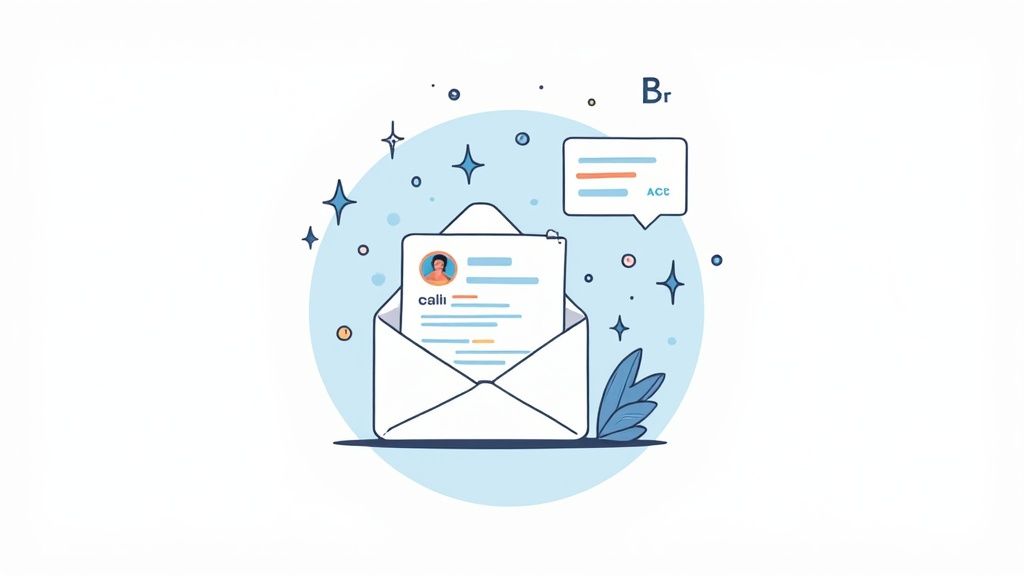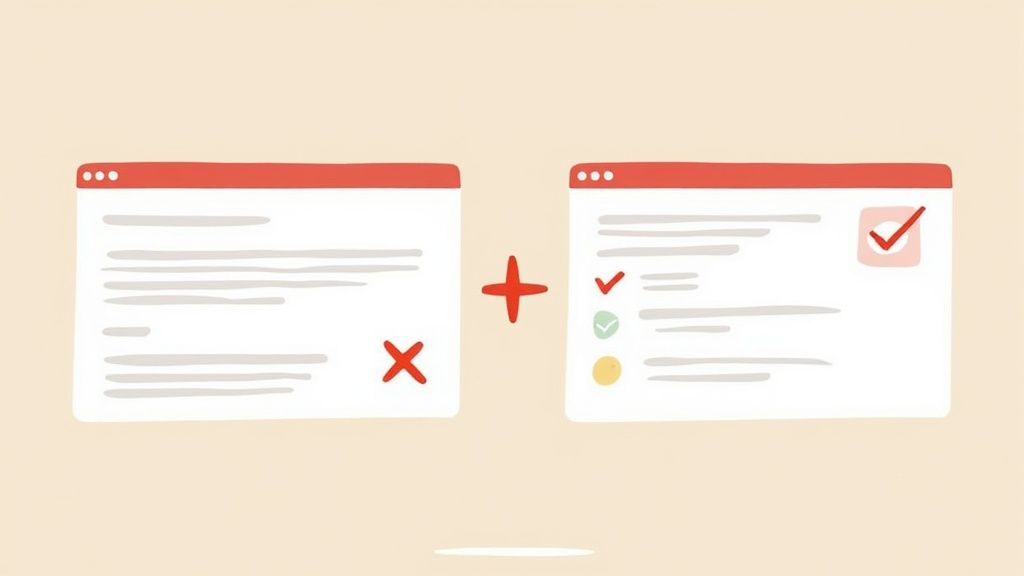Customer Journey Optimization: From Confusion to Conversions
Discovering What Your Customers Actually Do (Not What You Think)
Let's be honest, it's a tough pill to swallow, but many businesses are working with a fictional story of their customer's path to purchase. We sit in boardrooms and map out these perfect, straight-line funnels from a social media ad directly to checkout. But the real world is messy. The modern customer journey is more like a winding country road, full of detours through social media, review sites, and other touchpoints we never even considered. These assumptions aren't just a bit off; they're expensive, leading to wasted marketing dollars and sales slipping through our fingers.
The first step to true customer journey optimization is to admit we don't have all the answers. It’s about committing to find them in the data, not in our own wishful thinking. We need to trade our ideal scenarios for a clear-eyed view of what’s really going on.
From Assumptions to Actionable Insights
So, how do you uncover what your customers are really doing? It all starts by challenging what you think you know. Traditional funnels often miss the mark because they ignore the complex, non-linear ways people research and buy things today. A customer might see your Instagram ad, forget about it for a week, search for a competitor, read a blog post comparing your products, and then finally type your website address directly into their browser. That initial ad was a piece of the puzzle, but it was far from the whole story.
This is where a data-driven approach is no longer a "nice-to-have." For example, customer journey analytics is a powerful way to improve engagement by looking at interactions across every single channel. It helps you see exactly where the friction is—like where people bail on their shopping carts or show signs of frustration—so you can fix it. You can explore more about how journey analytics uncovers these critical moments by checking out these insights on FullSession.io.
To truly grasp the shift, it's helpful to compare the old way of thinking with a modern, data-backed method.
Traditional vs. Modern Customer Journey Mapping
| Aspect | Traditional Approach | Modern Data-Driven Approach | Impact on Results |
|---|---|---|---|
| Data Source | Assumptions, internal workshops, anecdotal feedback. | Real-time user behavior data (analytics, heatmaps), customer surveys, support tickets. | Moves from guesswork to evidence-based decisions, increasing accuracy. |
| Journey Model | Linear and funnel-based (Awareness > Interest > Decision > Action). | Non-linear, cyclical, and multi-channel, acknowledging multiple touchpoints. | Catches complex paths, reducing missed opportunities for engagement. |
| Focus | Pre-purchase stages and converting new customers. | The entire customer lifecycle, including post-purchase, loyalty, and advocacy. | Builds long-term relationships and increases lifetime value (LTV). |
| Updating | Static; updated annually or when a major campaign launches. | Dynamic; continuously updated based on new data and customer behavior. | Allows for quick adaptation to market changes and customer needs. |
The key takeaway here is the move from a static, internal "best guess" to a dynamic, customer-centric map that reflects reality. This shift is what separates brands that struggle from those that build a loyal following.
This infographic paints a clear picture of the opportunity at hand: while 70% of companies are mapping their journey, 68% of consumers expect a personalized experience. Optimizing the journey can boost conversions by an average of 25%.

The data clearly shows a gap between what businesses are doing and what customers want, with a huge potential upside for those who can bridge that divide.
Warning Signs Your Map Is Wrong
How do you know if your current understanding is leading you down the wrong path? Keep an eye out for these red flags in your data:
- High cart abandonment rates: Shoppers are getting all the way to the finish line, but something is making them hesitate.
- Low engagement on key pages: Are your most important, "money-making" pages being largely ignored?
- Unexpected drop-off points: Your analytics show people leaving from pages you assumed were performing well.
- Poor repeat purchase rates: The experience after the first sale isn’t strong enough to bring customers back for more.
Each of these signs points to a major disconnect between your assumed customer journey and the one people are actually taking. Identifying them is the first step toward fixing the leaks and building a path that customers genuinely want to follow.
Finding the Touchpoints That Actually Move the Needle
Once you have a more honest picture of your customer's journey, the next challenge is figuring out where to focus your energy. Not every interaction carries the same weight; some are forgettable, while others are make-or-break moments. Smart customer journey optimization isn't about perfecting every single step—it's about identifying and improving the specific touchpoints that truly influence a customer's decision to buy and stay loyal.
I've seen many businesses waste months trying to fix everything at once, only to see minimal results. The real wins come from pinpointing those few critical interactions that pack the most emotional and financial punch. For an e-commerce brand, this might not be the homepage, but rather the unboxing experience or how easy it is to process a return.
Cataloging Your Customer Interactions
To find these high-impact moments, you first need a complete inventory of every possible interaction a customer can have with your brand. This process, often visualized in a journey map, goes beyond just website clicks. It should include every ad they see, every email they open, every social media post they scroll past, and every conversation with your support team.
Think about the entire experience from their perspective:
- Pre-Purchase: How do customers first discover you? This could be through social ads, blog posts you've written, influencer mentions, or simple search results.
- Purchase: What happens during the transaction itself? Consider the details on your product pages, the checkout process, payment options you offer, and the confirmation email they receive.
- Post-Purchase: How do you keep them engaged after the sale? This includes shipping updates, the unboxing moment, requests for feedback, and of course, your loyalty program.
Here is a visual example of what a customer journey map looks like, showing the stages and various touchpoints involved.

This map illustrates how a customer moves through different phases, from awareness to advocacy, highlighting their actions, thoughts, and feelings at each touchpoint. When you build a similar map, you can start to see potential friction points and opportunities. For instance, a 30% increase in conversion rates can often be traced back to simplifying just one or two confusing steps in the purchase phase.
Prioritizing which touchpoints to improve requires a mix of data and empathy. Look at your analytics to see where customers drop off, but also use surveys and feedback to understand the why behind their actions. A high drop-off rate on your shipping page might not be about cost, but about a lack of delivery options or unclear timelines. Combining quantitative data with qualitative feedback is the key to discovering the touchpoints that will give you the most significant return on your optimization efforts.
Making Sense of Customer Data Without Drowning in Numbers
Raw analytics can often feel like you're staring at an ocean of numbers, just hoping an insight will magically appear. But the secret to real customer journey optimization isn't about collecting more and more data; it's about learning to translate that data into the story of your customer. Just looking at website traffic, for example, tells you very little on its own. The real breakthroughs happen when you pair quantitative data (like clicks and conversion rates) with qualitative feedback (like survey responses and reviews).
Imagine you see a high drop-off rate on your checkout page. The numbers show you what is happening, but they don't explain the "why." A simple pop-up survey that asks, "What's stopping you from completing your purchase today?" can reveal the whole story. Maybe the shipping costs were a surprise, or a preferred payment option was missing. This combination of data turns a vague problem into a clear, actionable task: "We need to make our shipping costs visible on product pages."
From Metrics to Moments
To avoid getting stuck in "analysis paralysis," try segmenting customers based on their behavior during their journey, not just their demographics. This means grouping them based on the actions they take, which gives you a much clearer picture of their intent and what they need from you.
Think about these behavior-based segments:
- First-Time Visitors vs. Returning Visitors: Newcomers might need more trust-building content, like reviews or "about us" info. On the other hand, returning visitors might be looking for what's new or checking their loyalty perks.
- High-Intent Shoppers: These are the people adding items to their cart or using your search bar for specific products. Their journey needs to be as smooth and quick as possible.
- Hesitant Buyers: These folks might view a product several times or even abandon their cart. They often just need a gentle nudge, like a friendly reminder email or a small incentive to come back.
When you're trying to understand customer behavior across different channels, using the right tools is key to keeping your optimization efforts on track. There are many great platforms out there, and you can find a breakdown of the best social media analytics tools that can help centralize data from those important touchpoints.
The Power of Zero-Party Data
While analytics track what customers do, zero-party data—information customers willingly give you—tells you what they want. This includes preferences they share through quizzes, surveys, or when they sign up for your loyalty program. This is your golden ticket to truly personalizing the journey. If a customer tells you they're passionate about sustainable products, you can immediately tailor their experience to highlight those items.
Bringing this direct feedback into your strategy is a powerful move. You can learn more about how to collect zero-party data for your Shopify store to start building more authentic connections. This approach transforms data from a cold set of numbers into a warm, ongoing conversation with the people who matter most—your customers.
Building Experiences That Turn Customers Into Advocates
Getting that first sale feels great, but the real magic happens when you stop thinking about one-time transactions and start building lasting relationships. The most successful brands I've seen know that the customer journey optimization continues long after someone clicks "buy." It's about creating post-purchase experiences so good that customers don't just return—they tell their friends. This is how you turn a casual shopper into a genuine brand fan.

From Transaction to Emotional Connection
The key is to anticipate what your customers need before they even ask. Instead of a generic "thank you" email, what's next for them? For instance, a skincare brand I follow sends a short video tutorial two weeks after purchase showing how to get the best results from their product. It’s a simple touch, but it shows they care about my experience, not just my wallet. That’s how you build an emotional connection that a simple sale never will. The goal is to make every interaction feel personal and helpful without being creepy or intrusive.
This focus on the customer experience isn't just fluffy stuff; it directly impacts your revenue. A frequently cited statistic shows that 86% of buyers are willing to pay more for a great customer experience. This really drives home that improving the journey is a direct investment in your business's health. You can see more on the financial side of things in this detailed report from SuperOffice.
Nurturing a Loyal Community
Turning happy customers into loyal ones takes a bit more structure. This is where tools like loyalty programs really shine. Rewarding people for coming back gives them a concrete reason to choose you again. But it’s not just about earning points; it’s about creating a sense of belonging.
Here are a few practical ideas I've seen work well:
- Offer exclusive access: Give your most loyal customers a sneak peek at new products or early access to sales. It makes them feel like insiders.
- Create shared experiences: Host a live Q&A session or an online workshop related to what you sell. It builds a community around your brand.
- Recognize and reward advocacy: Use referral programs, like the ones you can set up with Toki, to genuinely thank customers for spreading the word.
By weaving these thoughtful touchpoints into your post-purchase strategy, you create a powerful cycle of repeat business and authentic referrals. To get more ideas on this, check out this piece on how to drive revenue with customer loyalty and engagement.
Responding Fast Without Losing Your Mind (Or Quality)
In a world of instant gratification, customer patience is a rare commodity. When people have questions, they want answers now, and the speed of your reply heavily influences how they see your brand. Trying to be everywhere at once is a surefire recipe for burnout and can paradoxically lead to a drop in the quality of your customer interactions. The answer isn't to work 24/7; it's to get smarter about your customer journey optimization. It's all about finding that sweet spot between a quick response and a real, human connection.
This isn't just a "nice-to-have." Immediate responsiveness is a massive driver of customer happiness. In fact, 90% of consumers say an immediate response is important when they have a service question. That statistic isn't just a number—it’s a clear directive from your customers. They expect speedy engagement at every touchpoint. You can find more details on how consumer expectations are changing the game.
To show just how much response time matters, we've put together some data that links speed to key business outcomes.
Response Time Impact on Customer Satisfaction
This table shows a clear analysis of how different response times affect customer satisfaction and conversion rates.
| Response Time | Customer Satisfaction Score | Conversion Rate | Customer Retention |
|---|---|---|---|
| Under 1 Minute | 92% | 35% | 85% |
| 1-5 Minutes | 85% | 28% | 78% |
| 5-30 Minutes | 70% | 15% | 65% |
| 30-60 Minutes | 55% | 8% | 50% |
| 1-2 Hours | 40% | 5% | 42% |
| Over 2 Hours | 25% | 2% | 30% |
As you can see, the data speaks for itself. A delay of just a few minutes can have a significant impact on satisfaction, conversions, and whether that customer decides to stick around. Waiting over an hour can be detrimental.
Balancing Automation and Human Touch
Let’s be realistic: you can't personally answer every single message the second it arrives. This is where automation can be a lifesaver, but only if you use it thoughtfully. Forget cold, robotic messages. Your goal is to create automated replies that feel genuinely helpful and manage expectations.
Here’s how you can do it:
- For simple questions: A well-programmed chatbot can instantly handle common queries like, "Where's my package?" or "What are your store hours?" This frees up your team to tackle the trickier problems that require a human brain.
- For complex issues: When a chatbot hits its limit, it should smoothly hand the conversation over to a live agent. Crucially, it needs to pass along the entire chat history so the customer doesn't have to repeat everything they just typed.
- For after-hours support: An automated reply can do wonders. It can confirm you got the message, give an estimated response time, and maybe even link to a helpful FAQ page. This simple gesture shows you care and stops frustration from building up.
Prioritizing What Really Matters
Not all customer messages carry the same weight. A question about a high-value item from a potential buyer probably deserves more urgent attention than a casual comment on a social media post. Creating a clear system to sort and prioritize incoming messages is key to an efficient workflow.
This isn't about ignoring anyone; it's about allocating your team's limited time to the interactions that most affect your bottom line and customer loyalty. When you nail this balance, you not only slash your response times but also actively reduce customer churn. If you're looking for more strategies on this, check out our guide on how to address the most common reasons for customer churn. By designing a support system that is both responsive and sustainable, you create a customer journey that feels quick, personal, and dependable—all without stretching your team to its breaking point.
Testing What Works (And Admitting When It Doesn't)

Even the most brilliant strategies for customer journey optimization are just educated guesses until they face the real world. This brings us to the final, and most crucial, part of the process: being willing to test your ideas and, just as importantly, admitting when they don't pan out. Real success isn't about getting it perfect on the first try; it’s about building a system that consistently uncovers what truly works through hard evidence, not ego.
This means you have to move past what looks good on a slide deck and start running actual experiments. For instance, instead of just launching a new welcome email series because it seems better, pit it against your current one. A classic A/B test, where you show one version to half your new subscribers and the old version to the other half, provides concrete data. Does Version A drive more first-time purchases? Does Version B get more people to join your loyalty program? Let the numbers be your guide.
Prioritizing Your Experiments
You can't test every single idea at once, so where should you begin? A framework I've found incredibly useful is prioritizing based on potential impact and how easy it is to implement. Zero in on changes that are fairly simple to execute but could make a big difference to a key metric, like the conversion rate on a product page or engagement on your post-purchase follow-ups.
Here's a straightforward way to categorize your ideas:
- High Impact, Low Effort: These are your quick wins. Think about changing a landing page headline or tweaking the call-to-action button in an abandoned cart email. These should always be at the top of your list.
- High Impact, High Effort: These are your bigger projects. Things like redesigning the entire checkout process or launching a new referral program with Toki fit here. They take more resources but have the potential for a massive payoff.
- Low Impact, Low Effort: These are minor tweaks and nice-to-haves. You can tackle them when you have some downtime, but don't let them distract you from the more significant tests.
Beyond the Numbers: Gathering Real Feedback
While A/B tests tell you what is happening, they don't always explain why. Never forget the simple power of asking your customers for their thoughts. Ditch the generic "How did we do?" surveys and ask specific, open-ended questions at just the right moments. Imagine a small pop-up after a customer completes a purchase that asks, "Was there anything in our checkout process that almost stopped you from buying today?" This kind of direct feedback is pure gold.
The end goal is to create a continuous loop where data from your tests and direct feedback from customers inform your next steps. Once you pinpoint something that works, keep testing and refining it. For more great ideas on improving your site's performance, this detailed website traffic conversion guide offers some excellent insights. When you embrace a culture of experimentation, your customer journey never gets stale; it constantly evolves to better serve the people who matter most—your customers.
Your Customer Journey Optimization Action Plan
Alright, you've done the hard work of mapping out your customer journey. Now, it's time to turn that knowledge into action. This is where customer journey optimization really starts to pay off. The idea isn't to tear everything down and start over, but to build a practical roadmap that gets you real results, starting today. Let's focus on the high-impact, low-effort changes first—the quick wins that build momentum and get everyone on board without needing a huge budget.
Quick Wins and Long-Term Vision
Start by tackling the most obvious friction points you uncovered. For most e-commerce brands, these are usually pretty common:
- Clarify shipping information: Don't make customers wait until the final checkout step to see shipping costs and delivery estimates. Add this information right on the product pages. It’s a small change that builds a lot of trust.
- Simplify the first purchase: Run an A/B test comparing a guest checkout option against mandatory account creation. I've seen brands get a 15% lift in conversion from this simple test alone. It removes a significant barrier for new shoppers.
- Improve post-purchase communication: Go beyond the standard receipt. Set up a single, automated email with helpful content, like a quick-start guide for the product or simple care instructions. It shows you're thinking about their experience even after the sale.
As you roll out these fixes, be sure to define what success looks like. Are you aiming to cut cart abandonment by 10%? Or maybe you want to increase repeat purchases by 5%? Having clear goals helps you celebrate your wins and keeps the team motivated for what's next.
Maintaining Momentum and Staying on Track
Once your first set of changes is live, the work doesn't stop. To keep the ball rolling, create a simple feedback loop. Set aside a short meeting every two weeks just to look at key metrics and read through customer comments. This keeps the focus on real data and avoids getting sidetracked by endless debates.
Keep an eye out for warning signs that you're losing focus. Are you chasing vanity metrics, like social media likes, that don't actually lead to sales? Are you getting bogged down in projects that require a ton of effort but deliver little impact? It’s easy to drift. To keep the journey fresh, think about new touchpoints you can improve. For a deeper dive into a powerful strategy, check out how you can use marketing with interactive video across every stage of the customer lifecycle.
Ready to make your action plan a reality? Discover how Toki can help you build a loyal community and drive repeat sales with our all-in-one loyalty platform.